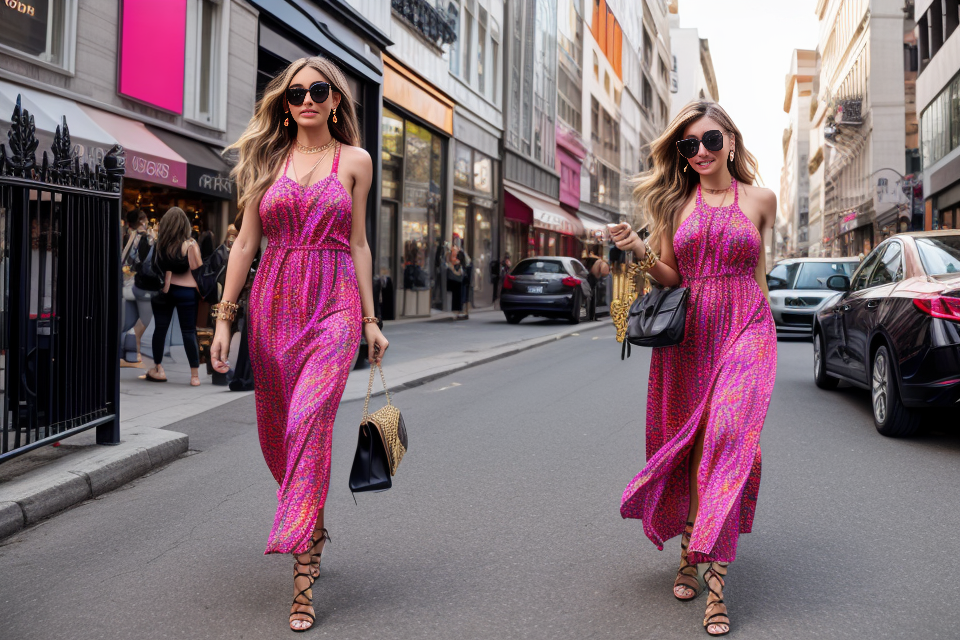
Clothing is an essential part of our daily lives, and we wear it for various reasons. But have you ever stopped to think about why we wear clothing? In this article, we will explore the five main reasons why people wear clothing. From protecting our bodies to expressing our personalities, the reasons are more diverse than you might think. So, let’s dive in and discover the fascinating world of clothing and the many reasons why we wear it.
Understanding the Functions of Clothing
Protection from the Elements
One of the primary functions of clothing is to protect the body from the elements. The clothing we wear serves as a barrier between our skin and the external environment, shielding us from extreme temperatures, wind, and water. Here are some ways in which clothing provides protection from the elements:
- Shielding the body from extreme temperatures: Clothing acts as an insulating layer, keeping the body warm in cold temperatures and cool in hot temperatures. Thicker and denser materials, such as wool and down, are better at retaining heat, while lighter and more breathable materials, like cotton and silk, are better at releasing heat. Additionally, clothing can be layered to adjust the amount of insulation needed based on the temperature.
- Keeping out water and wind: Clothing can also protect the body from water and wind, which can cause discomfort and even harm. Waterproof and windproof materials, such as Gore-Tex and fleece, are designed to repel moisture and wind, keeping the body dry and warm. Clothing can also be designed with special features, such as vents and zippers, to allow for air circulation and prevent overheating.
Overall, the clothing we wear plays a crucial role in protecting us from the elements, allowing us to enjoy outdoor activities and navigate different climates with comfort and safety.
Social Significance
- Clothing serves as a form of nonverbal communication, allowing individuals to convey their personal style and taste to others.
- Clothing can also be used to express cultural identity, reflecting the values, beliefs, and traditions of a particular group or community.
In today’s society, clothing has become a means of self-expression, enabling individuals to communicate their unique personality and style to others. This is achieved through the selection of clothing items that reflect an individual’s personal taste and preferences, such as certain colors, fabrics, and styles.
Furthermore, clothing serves as a means of social identification, allowing individuals to affiliate with specific cultural groups or communities. For example, wearing traditional clothing from one’s culture or heritage can be a way of preserving and celebrating cultural identity. Additionally, certain clothing items may be associated with specific subcultures or social movements, allowing individuals to express solidarity with like-minded individuals.
However, it is important to note that the social significance of clothing can vary greatly depending on the context and cultural norms of a particular situation. For instance, what may be considered appropriate or inappropriate attire in one culture may be viewed differently in another. Therefore, it is essential to understand the social context and cultural norms of a particular situation when considering the social significance of clothing.
Comfort and Convenience
- Enhancing physical comfort
- Clothing serves as a barrier between the body and the external environment, protecting us from temperature fluctuations, wind, and other factors that can cause discomfort.
- Soft and breathable fabrics, such as cotton and silk, allow for better air circulation, which can help regulate body temperature and keep us cool in hot weather.
- Insulating materials, like wool and down, trap heat and keep us warm in cold environments.
- Facilitating ease of movement
- Clothing is designed to accommodate the various movements of the body, allowing for a greater range of motion and increased flexibility.
- Loose-fitting garments, such as t-shirts and shorts, do not restrict movement and can even provide a sense of freedom.
- Tight-fitting garments, like spandex leggings or swimsuits, are designed to hug the body and provide support during physical activity.
- Some clothing items, like shoes and gloves, are specifically designed to enhance certain movements, such as running or cycling.
- Clothing can also serve as a protective barrier during activities that involve sharp objects, such as gardening or cooking, by providing a layer of material between the skin and the potential hazard.
Modesty and Privacy
Wearing clothing is not just about fashion, it also serves a functional purpose in preserving privacy and maintaining modesty. Clothing has been used for centuries to cover up certain parts of the body that are considered private or inappropriate to reveal in public. The concept of modesty is deeply rooted in various cultures and societies, and it continues to play a significant role in how people dress today.
- Preserving privacy: One of the primary functions of clothing is to preserve privacy. In many cultures, there are specific norms and expectations regarding what parts of the body should be covered in public. For example, in some cultures, it is considered inappropriate to show one’s legs or arms above the elbow in public. Wearing clothing helps individuals to adhere to these norms and maintain their privacy in public.
- Maintaining modesty: Another important function of clothing is to maintain modesty. In many societies, there are certain body parts that are considered private and should not be exposed in public. Clothing helps individuals to maintain their modesty by covering up these body parts. For example, wearing a bra and panties in public is considered immodest in many cultures, and therefore, people wear clothing that covers their chest and crotch area.
Overall, the concept of modesty and privacy is deeply ingrained in human societies, and clothing plays a crucial role in maintaining these values. It helps individuals to conform to societal norms and expectations regarding appropriate behavior and dressing in public.
Communication and Nonverbal Expression
- Sending nonverbal messages
- Demonstrating group affiliation
Sending Nonverbal Messages
One of the primary functions of clothing is to communicate nonverbal messages. Clothing can convey a range of messages, from conveying personal style to expressing cultural identity.
- Personal style: Clothing can communicate an individual’s personal style, such as their taste in fashion or their level of formality. This can help others understand an individual’s personality and values.
- Cultural identity: Clothing can also communicate cultural identity, such as religious beliefs or social status. For example, a person may wear a hijab to express their Muslim faith or a suit to convey their professional status.
Demonstrating Group Affiliation
Another function of clothing is to demonstrate group affiliation. This can be seen in the way that people wear clothing that represents their team, club, or organization.
- Sports teams: Fans often wear the team’s colors or logo to show support for their team. This helps to create a sense of community and belonging among fans.
- Clubs and organizations: Similar to sports teams, clubs and organizations may have specific clothing that members wear to show affiliation. For example, a person may wear a T-shirt with the logo of a political organization to show their support for the cause.
In summary, clothing serves as a means of communication and nonverbal expression. Through the clothing we wear, we can convey personal style, cultural identity, and group affiliation.
The Psychology of Clothing Choice
Personal Identity
Wearing clothing can be an expression of one’s personal identity, allowing individuals to build a sense of self and reinforce their social roles. Here are some key points to consider:
- Building a sense of self: Clothing choices can be a reflection of one’s personality, values, and interests. By selecting specific clothing items, individuals can convey their unique traits to others, contributing to the formation of their personal identity.
- Reinforcing social roles: Clothing serves as a nonverbal cue to one’s social role, such as profession, gender, or age. For example, wearing a suit and tie may signal that someone is in a professional role, while wearing a dress may indicate that someone is attending a formal event. By adhering to societal expectations related to dress, individuals reinforce their social roles and contribute to the understanding of their identity by others.
Additionally, personal identity can be shaped by cultural factors, as different cultures may have specific clothing traditions or expectations. Understanding the psychology behind clothing choice can provide insight into the complex interplay between individual and cultural factors that contribute to personal identity formation.
Self-expression
Clothing serves as a form of self-expression, allowing individuals to communicate their personal values and showcase their unique individuality. Here are some key aspects of self-expression through clothing:
- Communicating personal values: The clothes we wear can reflect our beliefs, political views, and social standings. For instance, wearing a t-shirt with a political slogan or a badge displaying a cause can communicate one’s stance on a particular issue. Similarly, wearing religious symbols or dressing modestly can signify one’s faith.
- Showing individuality: Clothing allows people to differentiate themselves from others and express their distinct personality. This can be achieved through various means, such as choosing unique patterns, colors, or styles that set them apart from the crowd. Moreover, accessorizing with items like hats, scarves, or jewelry can add a personal touch to one’s attire, highlighting their individuality.
Self-expression through clothing is not limited to these examples, as individuals can convey various aspects of their identity through their fashion choices. It is essential to recognize that while clothing can serve as a means of self-expression, it is also influenced by societal norms, cultural expectations, and personal preferences.
Social Influence
- Adapting to peer pressure
Peer pressure plays a significant role in our clothing choices. We often conform to the dress codes of our social group to fit in and be accepted. This is particularly evident in adolescence, where teenagers may dress in a particular style to belong to a certain clique or subculture. - Following fashion trends
Fashion trends also exert a powerful influence on our clothing choices. We may purchase clothes that are currently in vogue, even if they are not practical or comfortable, simply because they are considered fashionable. Fashion magazines, social media, and celebrity endorsements all contribute to the creation and dissemination of fashion trends, which can have a significant impact on our clothing choices.
Overall, social influence can shape our perceptions of what is considered fashionable or appropriate, leading us to make clothing choices that reflect these norms rather than our own personal preferences.
Emotional Comfort
One of the primary reasons we wear clothing is for emotional comfort. This type of comfort goes beyond the physical protection and temperature regulation that clothing provides. It involves the way clothing makes us feel emotionally and how it can influence our mood and behavior.
Providing comfort in difficult situations
Clothing can be a source of comfort during difficult times. For example, a favorite t-shirt or hoodie can provide a sense of security and familiarity during times of stress or anxiety. Wearing clothing associated with happy memories or events can also provide comfort and nostalgia.
Enhancing feelings of confidence
Clothing can also enhance our feelings of confidence. Certain types of clothing, such as formal wear or business attire, can make us feel more confident and professional in certain situations. This is often due to social and cultural norms associated with specific types of clothing. Wearing clothing that is comfortable and stylish can also boost our confidence and self-esteem.
Additionally, clothing can be used as a form of self-expression and personal branding. The way we dress can communicate our values, personality, and interests to others. By choosing clothing that reflects our individuality, we can feel more confident and authentic.
Overall, emotional comfort is an important aspect of why we wear clothing. It allows us to express ourselves, cope with difficult situations, and enhance our feelings of confidence and self-esteem.
The Environmental Impact of Clothing
Resource Consumption
- Water usage in production
- Clothing production requires large amounts of water for fabric dyeing, washing, and finishing processes.
- Cotton, for example, requires about 2,700 liters of water to produce one cotton shirt.
- In contrast, recycled polyester uses significantly less water, with about 10 liters needed to produce a shirt.
- Energy consumption in manufacturing
- Clothing manufacturing consumes significant amounts of energy for machinery, transportation, and heating/cooling.
- Synthetic fibers like polyester and nylon require more energy to produce than natural fibers like cotton and wool.
- However, the use of renewable energy sources like solar and wind power can reduce the carbon footprint of clothing production.
Waste Generation
The generation of waste is one of the most significant environmental impacts of clothing. With the fast fashion industry booming, clothing waste has become a major concern for the environment.
Textile waste in landfills
Textile waste in landfills is a significant contributor to environmental pollution. The majority of the world’s textile waste ends up in landfills, where it takes years to decompose. This waste releases harmful chemicals into the soil and groundwater, which can cause severe environmental damage.
Microplastics in oceans
Microplastics in oceans are another concern associated with clothing waste. Synthetic fibers, such as polyester and nylon, are not biodegradable and break down into microplastics, which are then ingested by marine life, leading to a decline in biodiversity. The microplastics also accumulate in the food chain, posing a threat to human health.
Furthermore, the production of clothing requires significant amounts of water and energy, leading to high carbon emissions and contributing to climate change. Thus, reducing clothing waste and adopting sustainable clothing practices is essential for protecting the environment.
Sustainable Alternatives
One of the most pressing environmental concerns surrounding the clothing industry is the significant waste generated by its production and disposal processes. Fast fashion, in particular, has been criticized for its high levels of waste and environmental harm. However, there are sustainable alternatives that can help mitigate these negative impacts.
Recycling and Upcycling
Recycling and upcycling are two of the most effective ways to reduce the environmental impact of clothing. Recycling involves breaking down old clothing and textiles to create new materials, while upcycling involves transforming existing clothing into new, higher-quality items. By recycling and upcycling, we can reduce the need for new resources and minimize waste.
Sustainable and Eco-friendly Materials
Another way to reduce the environmental impact of clothing is to use sustainable and eco-friendly materials. These materials are often made from renewable resources, such as bamboo, hemp, and organic cotton, and are produced using environmentally friendly processes. Sustainable materials are also biodegradable, which means they can be broken down by natural processes without causing harm to the environment.
Additionally, companies are now using innovative technologies to create sustainable materials. For example, some companies are using recycled plastic bottles to create fabric, which not only reduces waste but also creates a material that is more durable and long-lasting.
By using sustainable and eco-friendly materials, we can reduce the environmental impact of clothing production and disposal. Additionally, by choosing to recycle and upcycle our clothing, we can reduce waste and help to create a more sustainable fashion industry.
The Future of Clothing
Technological Advancements
As technology continues to advance, the way we think about and use clothing is evolving. Here are some of the most significant technological advancements that are shaping the future of clothing:
Smart Textiles
Smart textiles are fabrics that have been designed to incorporate electronic components, such as sensors and conductive fibers. These fabrics can change color, generate heat, or even monitor vital signs, making them ideal for use in medical and fitness applications. They can also be used to create interactive clothing, such as shirts that can display messages or play music.
3D Printing
3D printing is a technology that allows designers to create three-dimensional objects by layering materials, such as plastic or metal, one on top of the other. This technology has the potential to revolutionize the way we think about clothing production, as it allows for the creation of complex shapes and designs that would be difficult or impossible to produce using traditional methods. In addition, 3D printing can be used to create custom-fit clothing, which could greatly reduce waste and improve the fit and comfort of garments.
Changing Consumer Behavior
- Growing Environmental Awareness: With the increasing awareness of environmental issues, consumers are becoming more conscious of the impact of their clothing choices on the environment. This has led to a shift towards sustainable fashion, with consumers opting for eco-friendly materials and ethical production practices.
- Durability and Quality: Consumers are also placing a greater emphasis on the durability and quality of their clothing. With fast fashion dominating the market, many consumers are seeking clothing that can withstand the test of time and is worth the investment. This has led to a resurgence in the popularity of classic, timeless pieces that can be worn for years to come.
- Personalization and Individuality: In a world where technology has made it easier than ever to connect with others, consumers are seeking clothing that reflects their unique personalities and styles. This has led to a greater emphasis on customization and personalization, with many consumers opting for made-to-measure clothing or seeking out vintage and second-hand items that are one-of-a-kind.
- Health and Wellness: Finally, the growing focus on health and wellness has led to an increased interest in clothing that is not only fashionable but also functional. Consumers are seeking out clothing that is comfortable, breathable, and made from natural materials that are gentle on the skin. This has led to a rise in the popularity of activewear and athleisure, as well as a greater emphasis on the role of clothing in overall health and wellbeing.
Ethical Considerations
In recent years, there has been a growing awareness of the ethical implications of the clothing industry. As consumers become more conscious of the social and environmental impact of their purchases, they are demanding greater transparency and accountability from brands. Here are some of the key ethical considerations that are shaping the future of clothing:
Labor rights and fair trade
One of the most pressing ethical issues in the clothing industry is labor rights. Many garment workers around the world are paid poverty wages and work in unsafe and unsanitary conditions. In response to these concerns, many brands have implemented fair trade certification programs that ensure that workers are paid a living wage and that their rights are protected. Fair trade certification also helps to promote sustainable and environmentally friendly practices in the industry.
Animal welfare and vegan materials
Another important ethical consideration in the clothing industry is animal welfare. Many traditional materials, such as leather and fur, are derived from animals and can have a significant environmental impact. In response to these concerns, many brands are turning to vegan materials, such as synthetic leather and fake fur, which are more sustainable and ethical. These materials are often made from recycled plastic and other sustainable materials, which reduces the environmental impact of the clothing industry.
Overall, ethical considerations are becoming increasingly important in the clothing industry, and brands are responding by implementing sustainable and ethical practices throughout their supply chains. As consumers become more aware of these issues, they are demanding greater transparency and accountability from brands, which is driving innovation and progress in the industry.
FAQs
1. What are the 5 main reasons why people wear clothing?
The 5 main reasons why people wear clothing are:
1. To protect the body: Clothing provides protection from the elements, such as cold, rain, and sun exposure. It also protects the body from physical harm, such as cuts and bruises.
2. To modesty: Clothing helps to maintain modesty and privacy. It covers the body and prevents others from seeing it, which is especially important in cultures where nudity is considered private or taboo.
3. To express identity: Clothing is often used as a form of self-expression and to communicate one’s identity. People may choose to wear certain clothes to express their personality, values, or group affiliations.
4. To maintain social norms: Clothing is often used to conform to social norms and expectations. People may wear certain clothes to fit in with a particular group or to adhere to dress codes in certain settings, such as work or school.
5. To enhance comfort: Clothing can be worn for comfort and convenience. For example, people may wear loose-fitting clothes to stay cool in hot weather or warm clothes to stay warm in cold weather.
2. Why do people wear clothes to protect their bodies?
People wear clothes to protect their bodies from the elements and from physical harm. Clothing can provide insulation to keep the body warm, and it can also provide protection from the sun’s harmful ultraviolet rays. Clothing can also protect the body from cuts and bruises by providing a barrier between the skin and the environment.
3. How does clothing help to maintain modesty?
Clothing helps to maintain modesty by covering the body and preventing others from seeing it. In many cultures, nudity is considered private or taboo, and clothing is used to maintain a sense of privacy and modesty. Clothing can also be used to cover up parts of the body that are considered private or shameful, such as the genitals or breasts.
4. How does clothing express identity?
Clothing is often used as a form of self-expression and to communicate one’s identity. People may choose to wear certain clothes to express their personality, values, or group affiliations. For example, someone might wear a T-shirt with a political slogan to express their political beliefs, or someone might wear a certain style of clothing to identify with a particular subculture or fashion trend.
5. Why do people wear clothes to maintain social norms?
People may wear certain clothes to conform to social norms and expectations. Clothing can be used to signal membership in a particular group or to adhere to dress codes in certain settings, such as work or school. For example, a business suit might be worn to a job interview to signal professionalism, or a school uniform might be worn to signal belonging to a particular school.
6. Why do people wear clothes for comfort?
People may wear clothes for comfort and convenience. Clothing can be worn to regulate body temperature, to protect the skin from the elements, and to provide a barrier between the body and the environment. For example, someone might wear loose-fitting clothes to stay cool in hot weather or warm clothes to stay warm in cold weather. Clothing can also be worn for practical purposes, such as to protect the body from rough materials or sharp objects.


